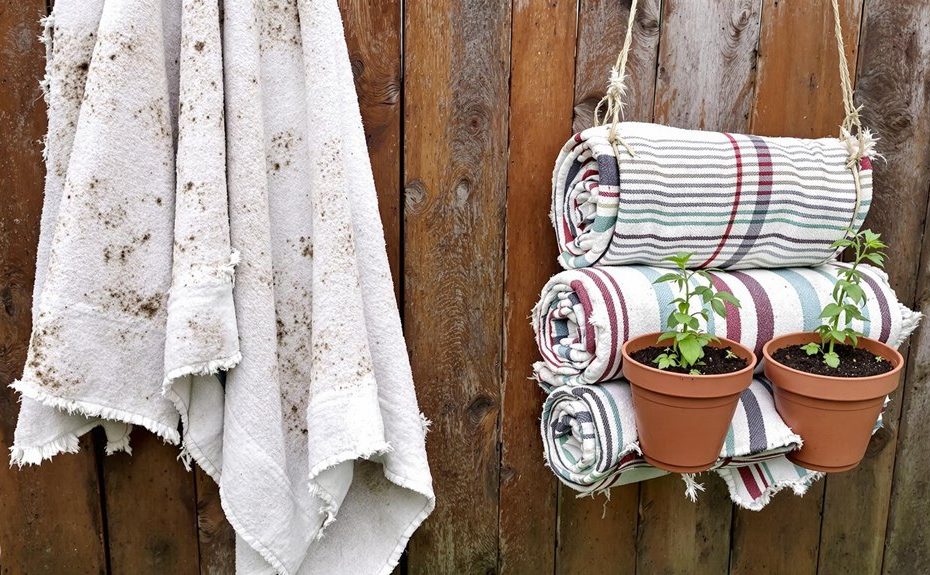Old towels represent an often-overlooked resource in our homes, with potential far beyond their original purpose. While most people discard these textiles after they’ve lost their pristine appearance or absorbency, their versatility makes them invaluable for numerous household tasks and DIY projects. From protecting surfaces during messy jobs to creating comfortable pet accessories, these humble items can serve as practical solutions for everyday challenges. Understanding how to repurpose old towels not only promotes sustainable living but also offers cost-effective alternatives for common household needs. The possibilities extend well beyond the bathroom, transforming what might be considered waste into useful tools for daily life.
Car Washing and Detailing
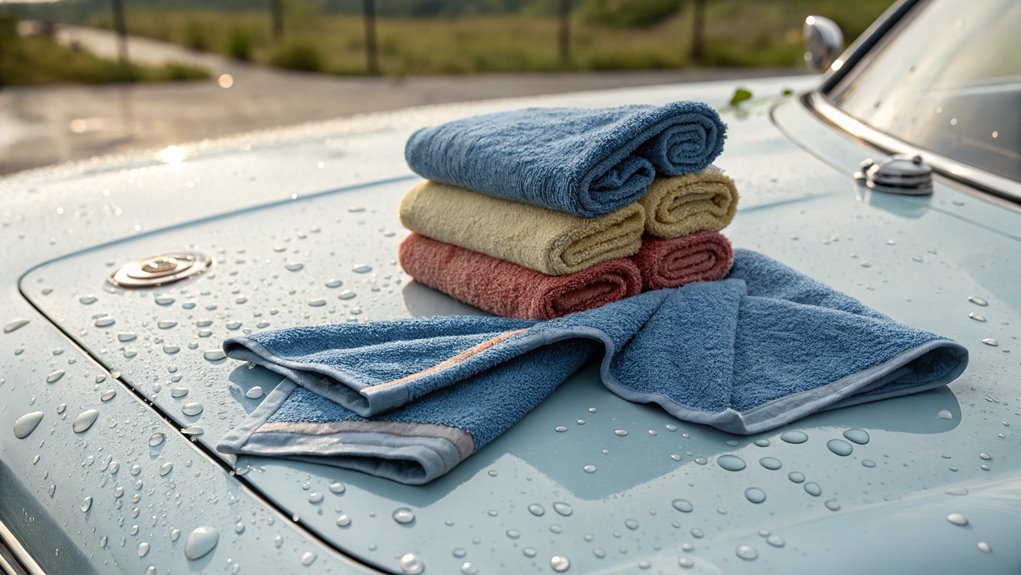
Old towels serve as ideal tools for washing and detailing vehicles, offering superior cleaning capabilities without risking damage to the car’s finish. You can use different towels for specific tasks – thick, absorbent ones for drying, and softer, worn towels for applying wax or polish.
When you’re washing your car, keep a stack of old towels handy. Use them to wipe down windows, clean wheel rims, and remove stubborn dirt from the exterior. They’re perfect for soaking up excess water after rinsing and can help prevent water spots from forming on your paint job. You can even keep a few in your trunk for unexpected spills or emergency cleanups. The best part? You won’t feel guilty about getting them dirty since they’re already at the end of their regular household life.
Pet Beds and Toys
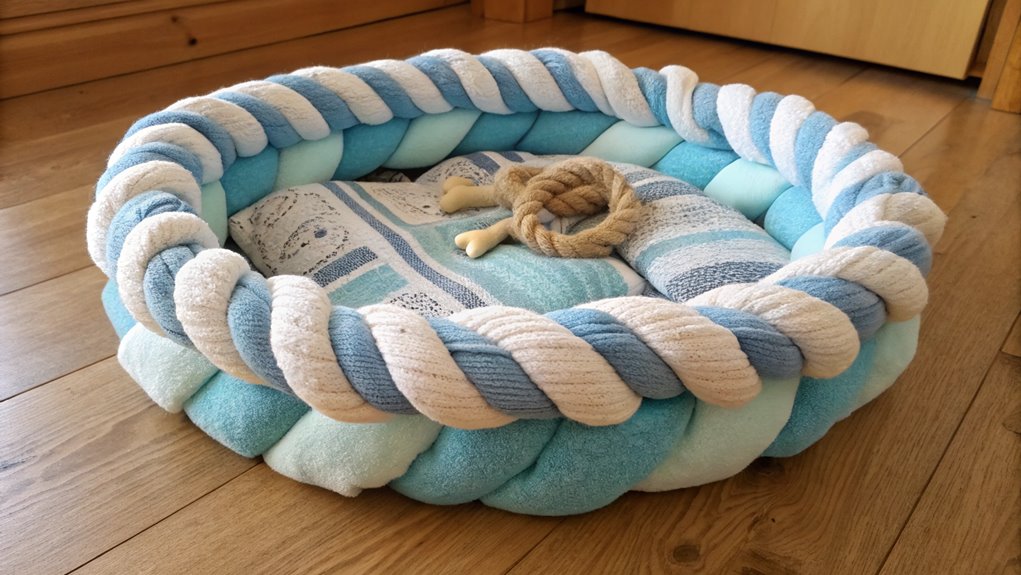
Repurposing towels into cozy pet beds and interactive toys provides a sustainable solution for pet owners while giving old textiles new life. You can create a simple pet bed by rolling several towels into a circular shape and securing them with strong stitches, or by filling a larger towel with smaller ones to make a cushy pillow your pet will love.
For toys, try cutting your old towels into strips and braiding them into a sturdy tug rope for dogs. You can also roll towels tightly and tie them in knots for durable chew toys. If you have a cat, twist smaller pieces into mice shapes and attach string for endless entertainment. Remember to wash the towels thoroughly before crafting, and always supervise your pets with homemade toys.
Garden Kneeling Pads
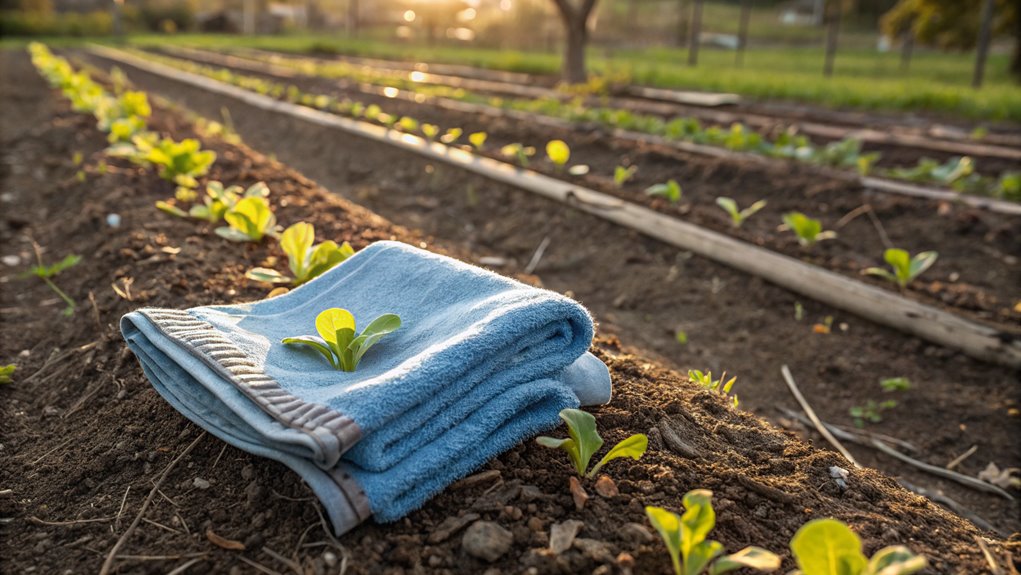
Kneeling in damp soil becomes more comfortable when thick, folded towels serve as garden pads. You can easily create these cushions by folding old bath towels into thirds or quarters, depending on your preferred thickness. When you’re working in your garden beds, these homemade pads will protect your knees from rocks, twigs, and moisture.
To make your towel pad last longer, you can sew a waterproof backing onto one side using an old shower curtain or plastic tablecloth. This will keep the dampness from seeping through. You might want to make several pads and keep them near your gardening tools – one for yourself and extras for when friends join you for weeding sessions. When they get dirty, just toss them in the washing machine and they’ll be ready for your next gardening adventure.
Garage Workshop Rags
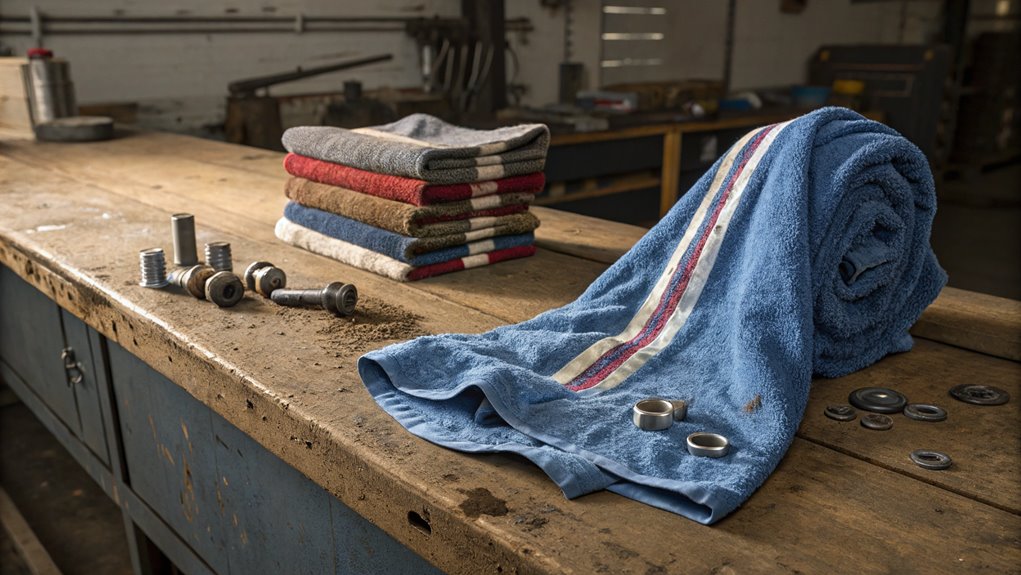
Converting bath towels into workshop rags provides an economical solution for cleaning, polishing, and maintaining tools and equipment in your garage. Simply cut your old towels into manageable sizes, and you’ll have a ready supply of absorbent cloths perfect for wiping up spills and grease.
These repurposed towels are particularly great for applying waxes and polishes to your car, as their soft cotton fibers won’t scratch the paint. You can also use them to clean your tools after each use, preventing rust and extending their lifespan. Keep a stack in your garage, and you’ll always have a rag handy when you need one. The best part? When they become too soiled, you can simply toss them in the washing machine or replace them with other old towels from your home.
Moving Day Protection
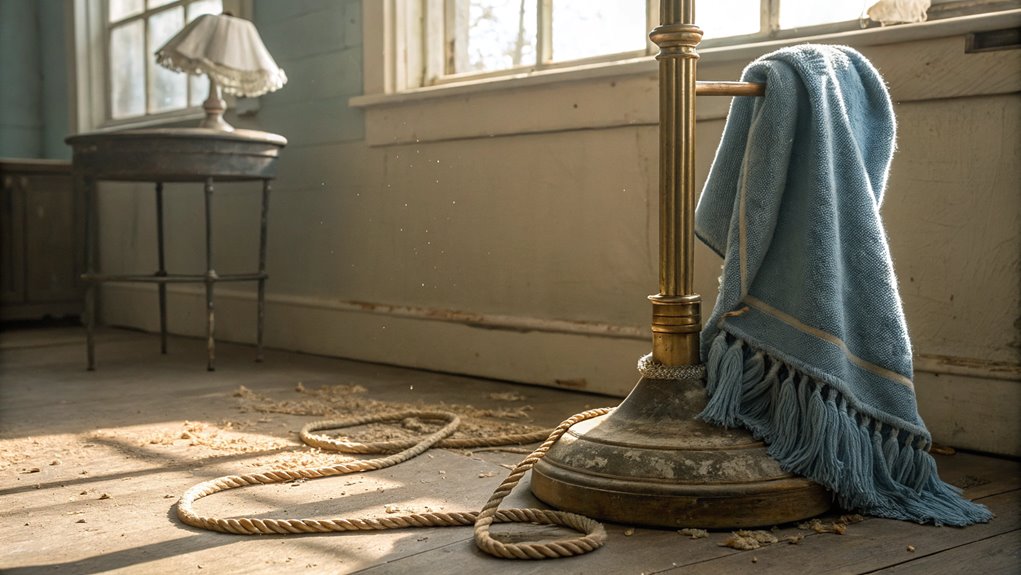
Old towels serve as valuable padding when moving furniture and fragile items to a new home. You can wrap your dishes, glassware, and picture frames in these soft, protective layers to prevent chips and scratches during transport. The thick fabric helps absorb shock and prevents items from bumping against each other in moving boxes.
When moving large furniture pieces, you can tuck towels between items to prevent scratches and dents. They’re perfect for protecting table corners, chair legs, and delicate wood surfaces. You can also lay them across the floor to prevent scratching your hardwood or tile when dragging heavy items. Once the move is complete, these same towels can help clean up any dust or dirt left behind in both your old and new homes.
Kitchen Spill Cleanup
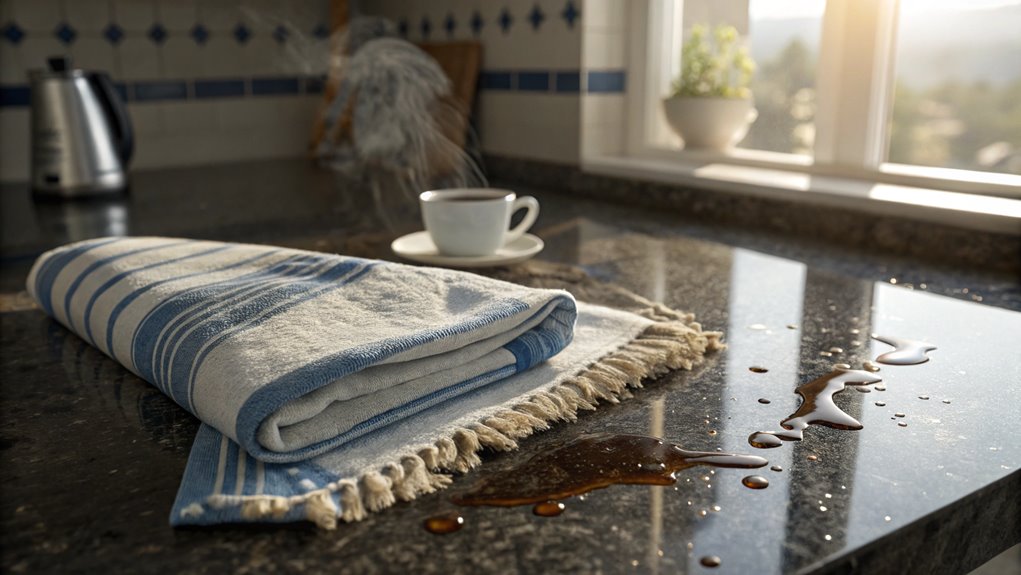
The humble towel proves invaluable for managing kitchen disasters, from minor spills to major messes. When you’re dealing with splattered tomato sauce or an overflowing pot, old towels can quickly contain the situation before it spreads across your counter or floor.
Keep a few worn towels in an easily accessible drawer for those unexpected kitchen emergencies. They’re perfect for wiping up coffee spills, soaking up cooking oil, or dealing with that bottle of juice that tipped over. Unlike paper towels that fall apart when wet, old bath towels have superior absorbency and durability. You can even cut them into smaller pieces to create custom-sized cleaning cloths that fit your needs. Plus, using old towels for cleanup is both eco-friendly and budget-smart.
Paint Project Drop Cloths
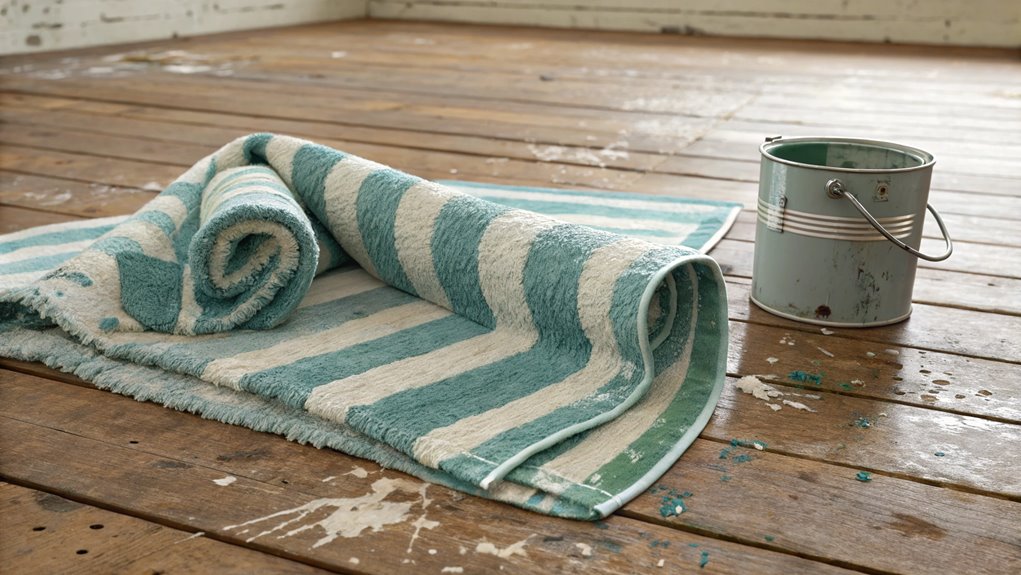
Savvy do-it-yourself painters know that repurposed bath towels make excellent drop cloths for home painting projects. Unlike plastic sheets that can be slippery and noisy, old towels stay firmly in place and absorb any paint drips or spills instantly.
You can lay these trusty towels under furniture while painting walls or spread them across your work surface when tackling craft projects. They’re especially handy for protecting hardwood floors and carpets from paint splatters. If you’re working on multiple rooms, simply shake the towels out between uses and keep going. When your project is complete, you can either wash the towels for future use or, if they’re too paint-soaked, dispose of them guilt-free since you’ve already gotten years of use from them.
Beach and Picnic Blankets
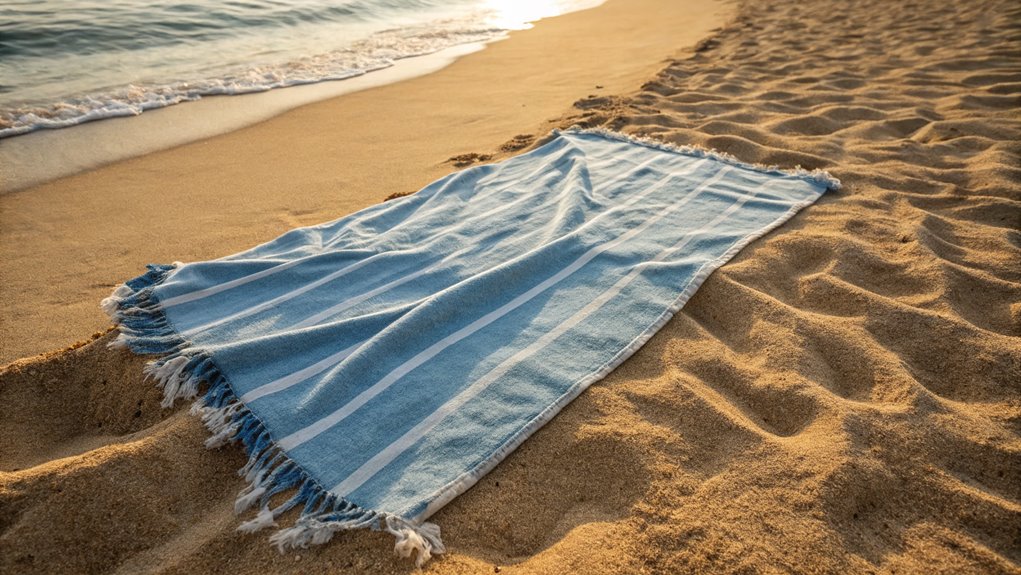
Moving from indoor projects to outdoor activities, repurposed bath towels serve as practical beach and picnic blankets. Their absorbent material makes them perfect for drying off after a swim or protecting you from damp grass during outdoor meals.
You’ll find that old towels are sturdier than typical picnic blankets and easier to wash after use. Simply shake off the sand or grass, toss them in the washing machine, and they’re ready for your next adventure. If you’re worried about size, you can easily sew multiple towels together to create a larger blanket that accommodates your whole family. For extra functionality, try adding a waterproof backing to your towel blanket – this will prevent moisture from seeping through when you’re sitting on wet sand or dewy grass.
Emergency Car Kit
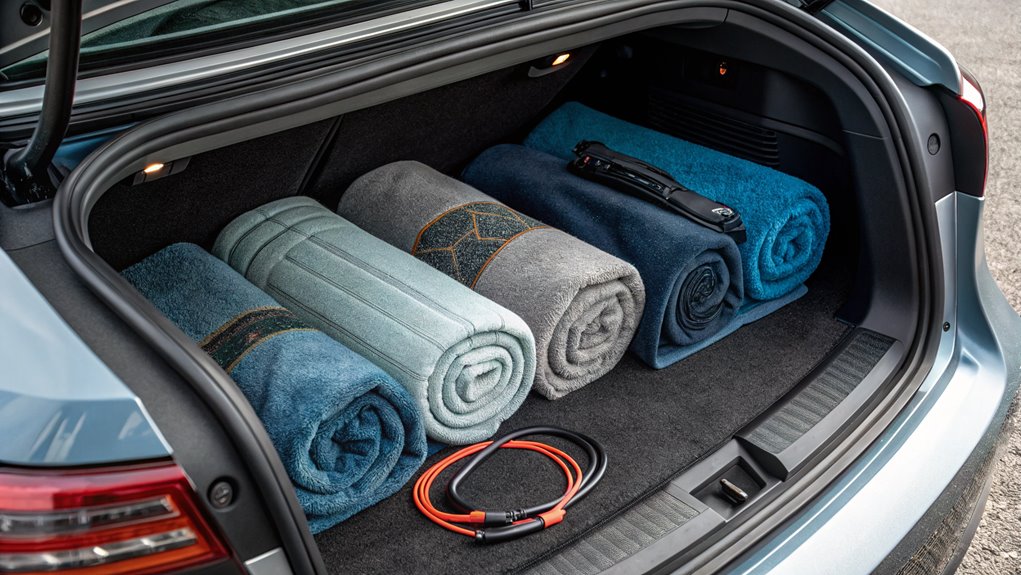
Every well-prepared vehicle should include old towels as part of its emergency kit. You’ll be thankful to have them when unexpected situations arise on the road. Keep at least two large towels in your trunk – they can be lifesavers in various situations.
If your car breaks down in the rain, you can use a towel to stay dry while checking under the hood. They’re perfect for protecting your knees when changing a tire or lying on the ground to inspect your vehicle. You can also use them to improve traction if your wheels get stuck in mud or snow. In winter, old towels can even serve as makeshift blankets if you’re stranded, and they’re great for wiping off foggy windows or soaking up spills inside your car.
Bathroom Floor Mats
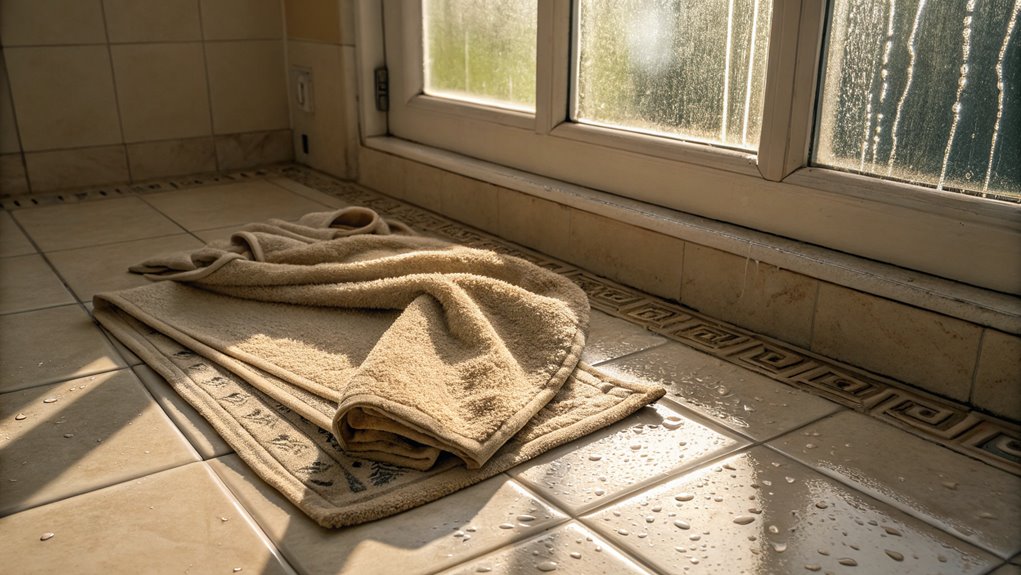
Transform your old towels into practical bathroom floor mats by cutting them to size and adding non-slip backing material. You’ll save money while creating custom-sized mats that perfectly fit your space. Plus, these repurposed towels are super absorbent and machine washable.
To make your DIY bath mat, simply measure your desired area and cut your old towel accordingly. You can use rubber shelf liner or special non-slip backing fabric from craft stores to prevent slipping. Attach it using fabric glue or a few simple stitches. For extra thickness, layer two towels together before adding the backing.
These homemade mats work especially well in front of showers, tubs, and sinks. They’re also great for kids’ bathrooms since you won’t mind if they get stained or need frequent washing.
Packing Material
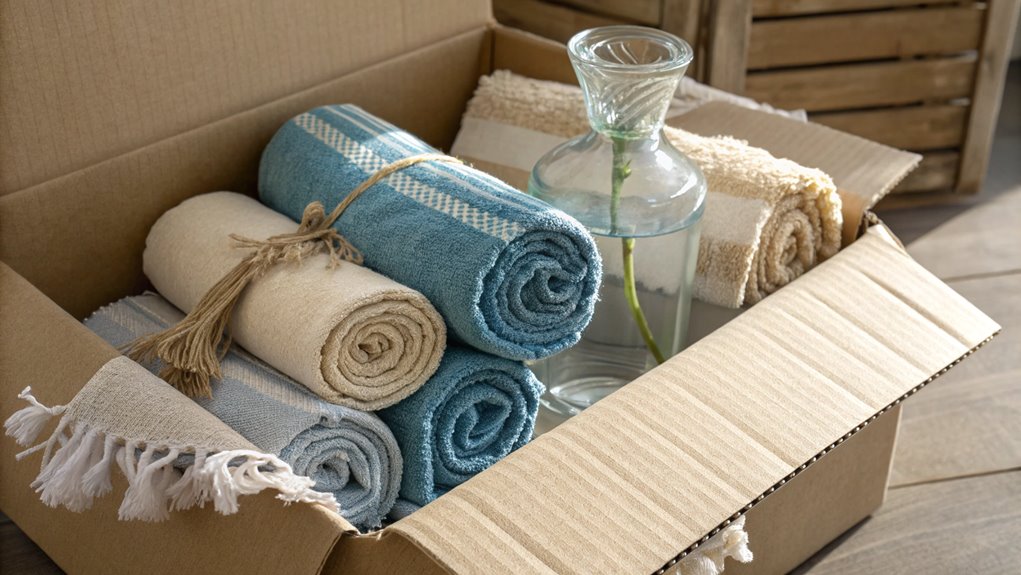
When protecting fragile items during a move, old towels serve as excellent cushioning material. You can wrap dishes, glasses, mirrors, and other delicate items in your old towels to prevent breakage. The soft, thick fabric provides better protection than newspaper and won’t leave ink marks on your belongings.
If you’re shipping items, old towels can replace bubble wrap or packing peanuts, saving you money while being more environmentally friendly. Simply layer them between fragile objects or use them to fill empty spaces in boxes. You can even cut larger towels into smaller pieces for wrapping individual items. When you arrive at your destination, just wash the towels and repurpose them again. It’s a practical way to give your old towels new life while keeping your valuables safe.
Camping Gear
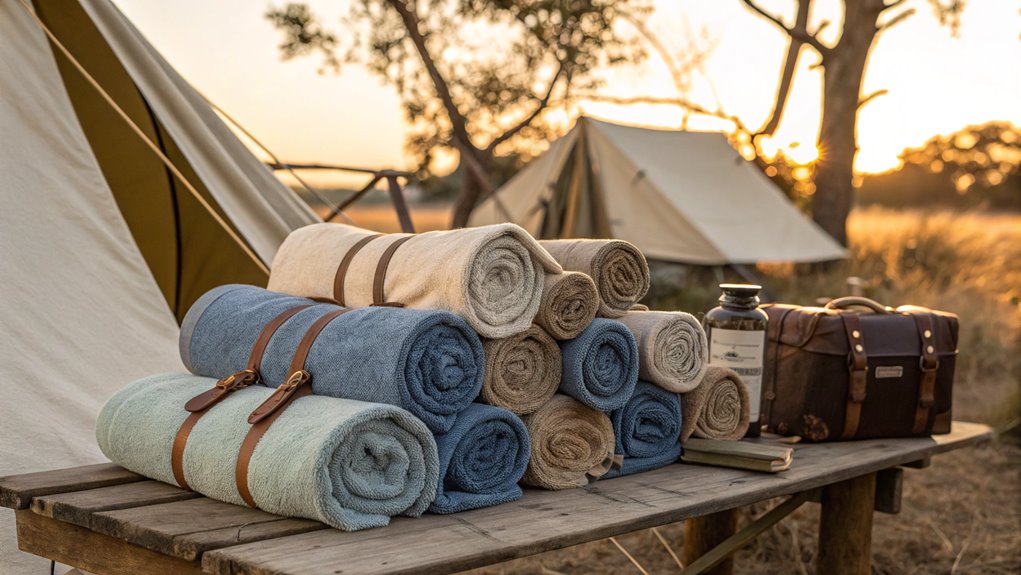
Old towels are invaluable additions to any camping arsenal. You can use them as makeshift pillows, extra blankets on chilly nights, or ground covers beneath your sleeping bag. They’re perfect for drying off gear after unexpected rain or wiping down tent walls covered in morning dew.
Keep a few old towels in your camping kit for cleaning muddy boots before entering your tent, or use them as emergency seat cushions around the campfire. They also work great as dish-drying stations when you’re washing cookware at your campsite. If you’re car camping, roll up a towel and place it under your tent for added cushioning on rocky ground. In emergencies, towels can even serve as temporary bandages or slings until you can reach proper medical care.
Dust Covers
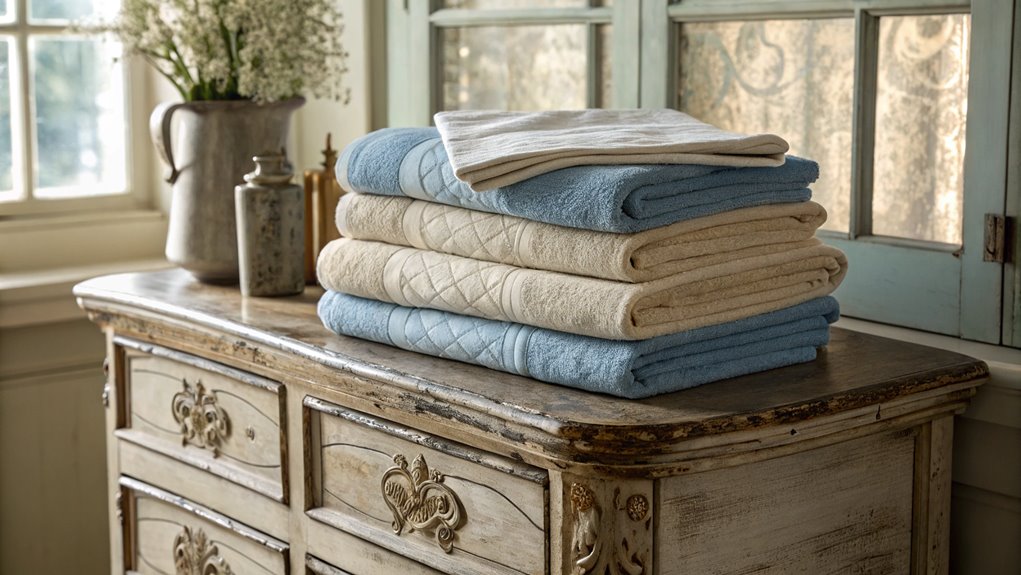
Retired bath towels make excellent dust covers for protecting stored furniture, appliances, and seasonal items. When you need to store your patio furniture for winter or pack away holiday decorations, old towels can keep everything clean and scratch-free. They’re especially useful for covering delicate electronics and small kitchen appliances you don’t use often.
You can easily customize these makeshift dust covers by cutting towels to size or stitching multiple pieces together. The thick terry cloth material traps dust better than thin sheets or plastic covers, and it’s breathable enough to prevent moisture buildup. Plus, if you’re storing items in a garage or basement, towel covers provide an extra layer of cushioning against accidental bumps. Best of all, you’re giving those old towels a second life while saving money on expensive store-bought covers.
Gym Equipment Wipes
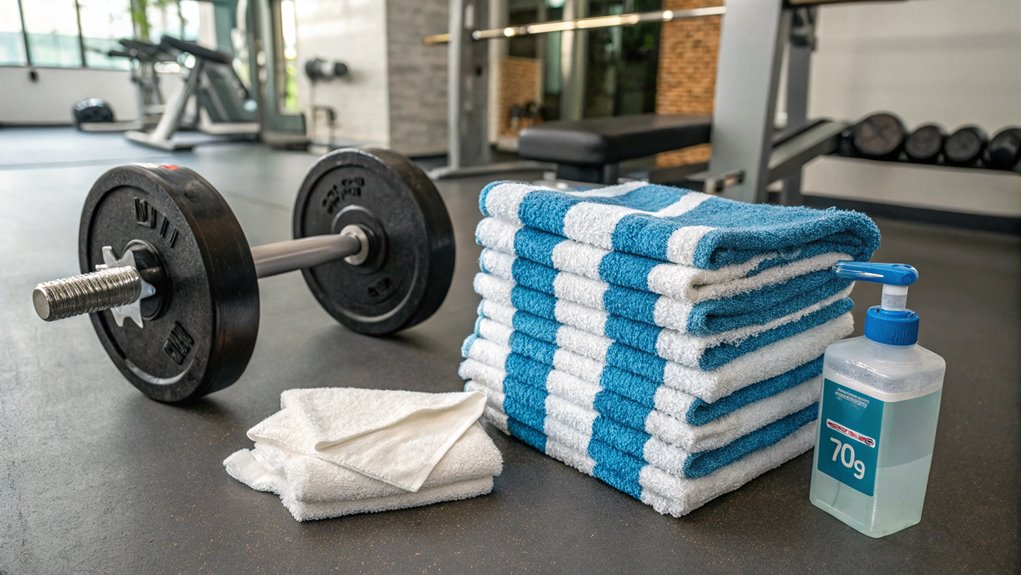
Cut into convenient squares, used bath towels can be transformed into effective gym equipment wipes. These absorbent squares are perfect for wiping down exercise machines, weights, and yoga mats after your workout. You’ll save money while being eco-friendly by reusing your old towels instead of buying disposable wipes.
Keep a stack of these homemade wipes in your gym bag, along with a small spray bottle of cleaning solution. After each use, toss them in a separate mesh bag until you get home to wash them. They’re especially handy for those sweaty cardio sessions when you need to clean multiple machines. Since terry cloth is durable, your DIY gym wipes will last through many washing cycles, making them a practical choice for your fitness routine.
Pet Grooming Station
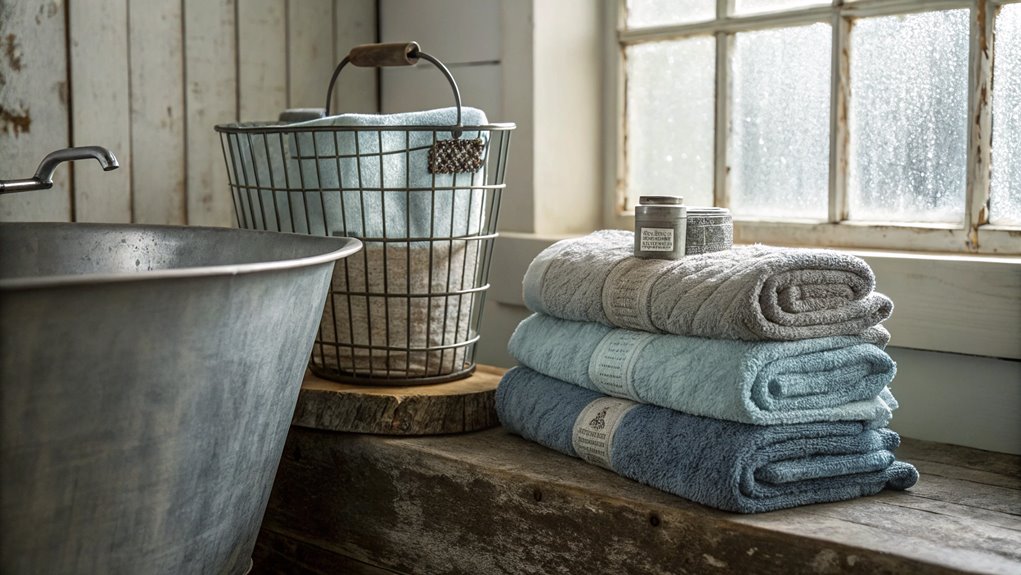
Transform your bathroom or laundry area into a pet grooming station by laying down several old towels to create a non-slip, absorbent surface. This simple setup will protect your floors and give your pet secure footing during bath time.
Keep a stack of old towels nearby to quickly dry your furry friend after washing. You can use one towel to gently pat their face and ears, while using another for their body. Having multiple towels on hand means you won’t struggle with a single soaked towel when drying thick or long fur. You can also wrap smaller pets in a towel to keep them warm and calm after bathing. When you’re done, just toss the dirty towels in the wash, and they’ll be ready for next time.
Frequently Asked Questions
How Long Should I Keep Towels Before Considering Them Too Old to Use?
While a luxurious new towel feels heavenly, even the best ones won’t last forever. Most towels should be replaced every 2-3 years with regular use. Watch for signs like losing absorbency, lingering musty smells despite washing, frayed edges, or thinning fabric. If you’re drying off and notice your towel’s just pushing water around instead of absorbing it, that’s your cue to go shopping for replacements.
Can Old Towels Be Composted in My Backyard Compost Bin?
Yes, you can compost old towels, but only if they’re made from natural fibers like 100% cotton or linen. Cut them into small pieces first to help them break down faster. Avoid composting towels with synthetic materials like polyester, as these won’t decompose. Also, make sure your towels are clean and free from chemicals or fabric softeners before adding them to your compost bin.
Are There Any Safety Concerns When Using Old Towels Around Electrical Equipment?
Just as a single spark can ignite a forest fire, using damp or frayed towels near electrical equipment can create dangerous situations. You should never use old towels to cover or clean plugged-in electrical devices, as fabric fibers can conduct electricity when wet. Even seemingly dry towels can trap moisture and create fire hazards. If you must clean electronic equipment, use specialized cleaning materials and always disconnect power first.
What’s the Best Way to Sanitize Old Towels for Reuse?
To sanitize old towels effectively, wash them in hot water (at least 140°F) with regular detergent and add one cup of white vinegar or bleach. Run them through an extra rinse cycle to remove all cleaning agents. Dry them completely on high heat to kill remaining bacteria. For extra sanitization, you can also pre-soak towels in boiling water with vinegar for 15 minutes before washing.
How Can I Tell if My Old Towels Contain Harmful Synthetic Materials?
Like detecting a wolf in sheep’s clothing, identifying synthetic materials in old towels isn’t always obvious. You can check the care label first – look for terms like polyester, nylon, or microfiber. If the label’s gone, try the burn test: clip a small piece and burn it safely. Natural fibers like cotton turn to ash, while synthetics melt and give off a plastic smell. The towel’s texture can also help – synthetics often feel slicker than cotton.
